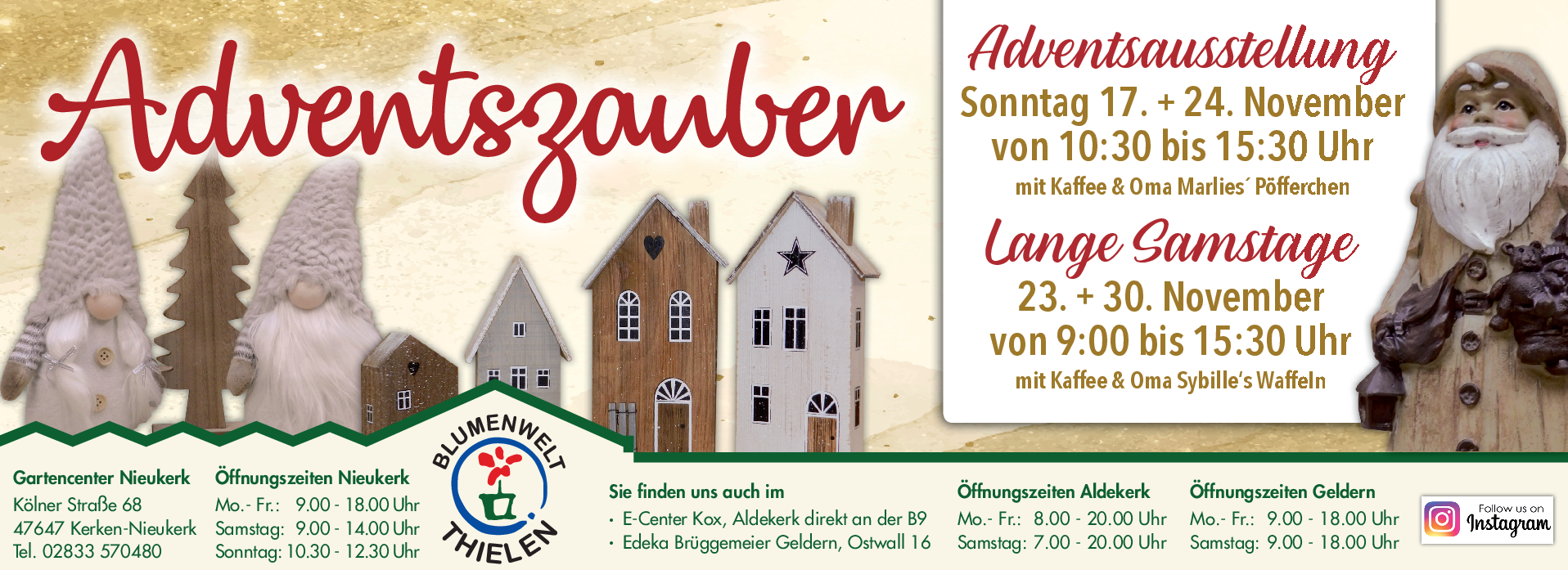At first glance, Nieukerk clearly sounds like the Lower Rhine, but also a little like its actual proximity to its Dutch neighbor. The part of the municipality of Kerken, which sounds like a regional Platt, is correctly pronounced “Neukerk”. At the same time, the contrast in name to the Aldekerk district is evident here, even though its church is the newer one. The two places have now been united in a common municipality for more than 55 years, which, along with the other districts of Eyll and Stenden, has the neutral name Kerken.
Tuesday: 9:00 a.m. – 6:00 p.m.,
Wednesday: 9:00 a.m. – 6:00 p.m.,
Thursday: 9:00 a.m. – 6:00 p.m.,
Friday: 9:00 a.m. – 6:00 p.m.,
Saturday: 9:00 a.m. – 2:00 p.m.,
Sunday: 10:30 a.m. – 12:30 p.m.” ad-id=”690843″ data-clickout-url=””/>
The community is currently scratching the 13,000 population mark. Kerken lies clockwise between the cities of Geldern, Kempen and Straelen (Viersen district) and between the communities of Issum, Rheurdt and Wachtendonk (Kleve district). Due to the many rural neighbors, the municipal constellation could have turned out differently. But five years before the major regional reform in North Rhine-Westphalia in 1975, Nieukerk and Aldekerk were “forced married” under pressure from the state administration against the will of the citizens. Both places had long had a mutual dislike for each other, and so the locals promptly dubbed the working group on municipal reorganization a “murder commission.”
The legal act from the summer of 1969 is a thing of the past, and at the “marriage celebration” of the “Golden Wedding” in 2019, the advantages such as the streamlined administration, the improved infrastructure and jointly supported major projects were highlighted. However, both places have preserved their historic life around their church towers and remain socio-culturally distant. By the way, Nieukerk also includes the districts of Baersdonk, Winternam and Poelyck.
Anyone who visits the larger, former workers’ village of Nieukerk as a non-resident will be able to see the city-wide motto “Simply worth living in”. Nieukerk takes up almost two thirds of Kerken’s total area of 58 square kilometers. The landscape is varied and there are plenty of opportunities for walking, dog walking, cycling and hiking past meadows, fields, smaller and larger bodies of water or farms.
On the outskirts there are some opportunities to shop at the farmers’ market or café or to stop off at pubs and restaurants. While the approximately 120 “Wanderfreunde Nieukerk” expand their horizons on external tours, young people especially enjoy the youth site. With a football field and skate park, this is a popular meeting place for kickers, skaters and spectators. By the way, the pump track course in Aldekerk is an attractive and modern equivalent for BMX bike off-roaders.
Both places are also a good starting point for a long walk to Lake Eyller and the rural St. Hubertus Chapel. The municipality of Kerken offers on its website www.kerken.de a downloadable file in PDF format with twelve different cycling routes and additional information about rental bikes or e-bike charging stations.
Pedestrians have it easier in the tranquil town center of Nieukerk around the Webermarkt: they can stroll on foot in the beautiful and well-kept brick idyll with alleys, squares, tree decorations, classic lanterns, lovely shops and equally inviting restaurants. The church tower of St. Dionysius towers high above the backdrop of historic house facades such as the Michael Bux community center, named after the legendary local cartographer and surveyor, or the late classicist Lawaczeck town house, named after a family of manufacturers. If you like it quiet, are weather-tested and careful, you can also take the overland road along Schietweg. What sounds indelicate means the crossroads that used to mark the parish boundary near Eyll between Nieukerk and Aldekerk.
HISTORY
Nieukerk is synonymous with the church built around 1180 in the neo-Gothic style. The site of the medieval church, which was built in its current dimensions as the parish church of the later bailiwick of Gelderland under the Counts of Geldern, previously belonged to the Winternam farming community. The presumed court chapel of Eyll in turn became the “Alden Kerk” and an independent parish in the 13th century. In modern times, the affiliation passed first to the Duchy of Guelders, then to the Kingdom of Prussia, and in between was under Napoleon’s French administration. The two offices later belonged to the Prussian district and the Federal German district of Geldern. The municipality of Kerken, which was newly formed in 1969, has been part of the Kleve district since the reorganization of North Rhine-Westphalia in 1975.
CLUBES AND TRADITIONS
The Nieukerk advertising ring with around 100 business people enlivens local life with a few events each year. The Webermarktfest is particularly popular with live music, children’s programs and Sunday shopping. But the sponsoring association of the Adlersaal community hall also speaks for itself. Behind it are eight local clubs that represent specific areas and seasonal highlights: The multi-division sports club TSV 95/19, which describes itself as the “largest Nieukerker club” with around 1200 members, the local history club, the music club in 1908, the men’s choir from 1849, the brotherhoods of St. Sebastianus 1348 and St. Johannes 1595, the Carnival parade club and the Nieukerker Elferrat. A major event is the art and culture summer that takes place every three years. Next date is 2026.
BY ARND WESTERDORF
{“ad-690843”:{“id”:690843}}


